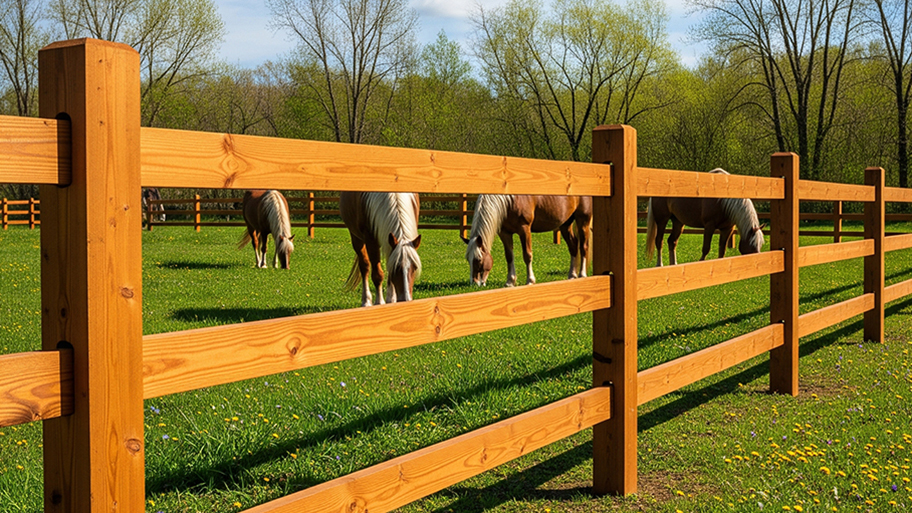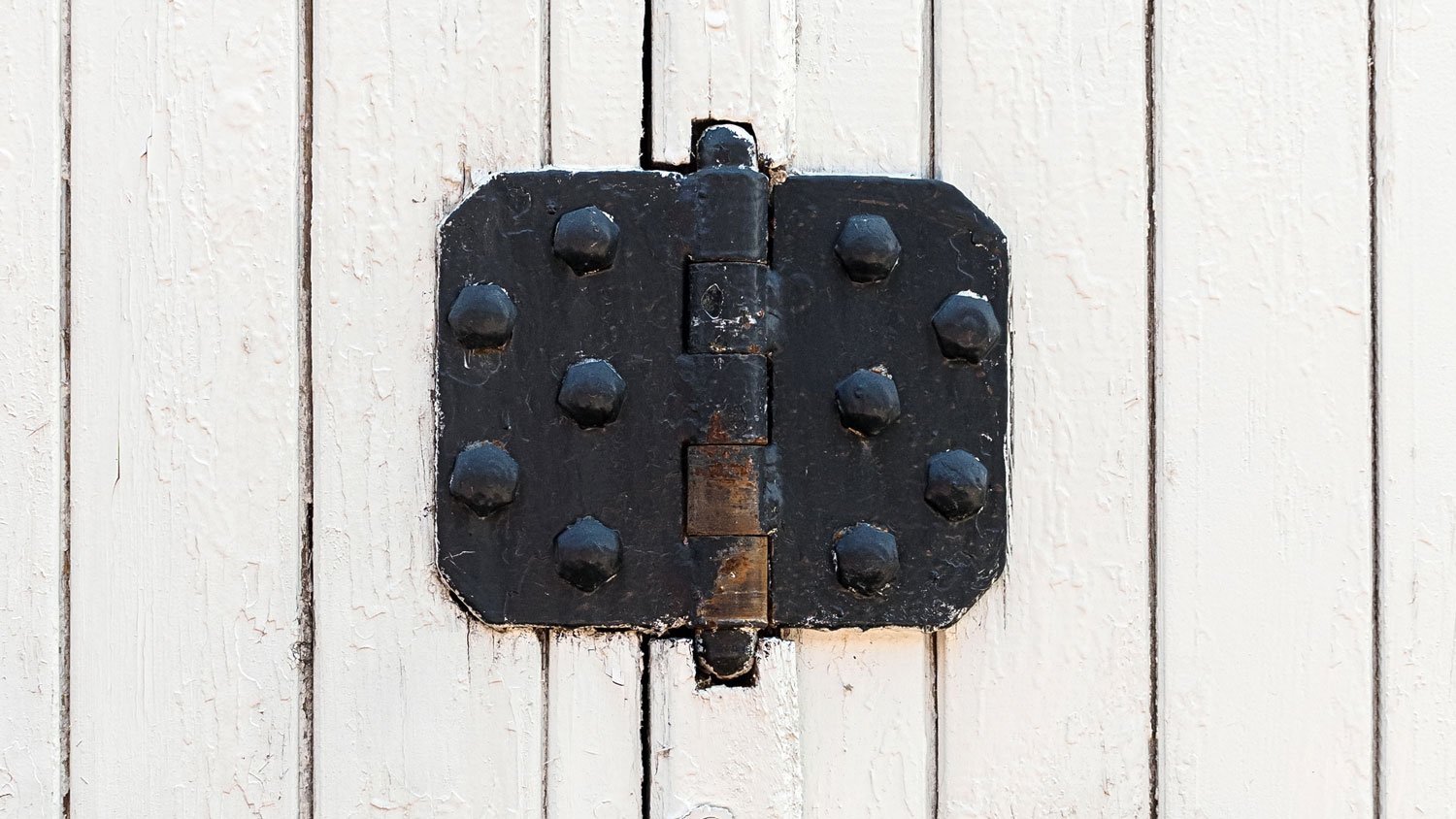
Looking for that rustic charm only a split rail fence can provide? Use this split rail fence cost guide to get an idea of what your fence will total.
Ensuring your gate project doesn't get unhinged


Gate hinges are like the tools you have in your garage: each one serves a specific purpose with its own pros and cons. Selecting the right hinge for your gate hinges (pun intended) on factors like the gate’s size, weight, and material, along with your particular requirements.
Hinges are available in different materials but are most commonly made from steel, brass, iron, or aluminum. Steel and iron are top choices due to their exceptional strength, durability, and resistance to corrosion from outdoor weather. All types of hinges are appropriate for wood, vinyl, composite, and metal gates, though the latter may require welding. However, it is essential to check the manufacturer’s instructions for additional information when shopping for hinges to ensure a hinge is a good fit for your gate.
Let's explore some common gate hinge types and see which one is the right tool for your gate.


The most common type of hinge is the butt hinge because it is a robust and reliable hardware component. Also called a mortise hinge, it consists of two rectangular plates, or "leaves," joined together by a central pin. One leaf is attached to the stationary frame, while the other is secured to the gate.
The standard size for a gate is 4 ½ inches with a thickness ranging from 3 to 3 ½ millimeters. The ball bearing sits between the knuckles and functions as a cushion, effectively diminishing friction. Most projects will require at least two hinges.
| Pros | Cons |
|---|---|
| Durable | Higher cost |
| Easy to hide or disguise | Uneven weight distribution |
| Easy installation | High-maintenance |
Best for: Lightweight gates
Strength and durability: While typically used for lighter gates under 100 pounds, many types of heavy-duty butt hinges can typically support several hundred pounds.
Discreet: They are smallish and occupy little space on the gate, which could make them a great choice if you want a clean look.
Simple installation: Because they are surface-mounted most DIYers can install a butt hinge without using special tools.
Cost: The average price for a heavy-duty butt hinge suited for gates ranges from $20 to $100, based on the weight of the gate, which can stretch tight budgets.
Gate stability: It may become an issue over time because these hinges put pressure on select points, not distributing weight evenly.
Maintenance: Hinges require occasional maintenance or light repairs by a local professional, such as lubrication or tightening of screws, to ensure longevity.
Not suitable for wide gates: These hinges are shorter than others, so they work best on gates under 4 feet wide.

The standard piano hinge size for gates and doors is 72 inches, making them an excellent option for tall gates due to their construction. These hinges feature a central pin and leaves of equal measure that extend along the entire length of a gate.
| Pros | Cons |
|---|---|
| Good weight distribution | Higher cost |
| High stability and durability | Style limitations |
| Smooth opening | Difficult installation |
Best for: Tall gates
Impressive weight-bearing capacity: These hinges distribute weight along their full length evenly, which eliminates stress on specific points.
Enhanced stability: Because of their length, piano hinges provide outstanding stability to gates, reducing the risk of sagging or warping over time and ensuring the gate remains level and fully functional.
Smooth operation: Thanks to their continuous design, piano hinges offer frictionless movement, resulting in a gate that opens and closes quietly and with minimal effort.
Customizable length: Piano hinges can be easily cut to the desired length, allowing for flexibility in gate design and installation.
Higher cost: Piano hinges available in the standard length of 72 inches range from $50 to $500—however, you only need to purchase one for most projects.
Aesthetic considerations: They provide a sleek and minimalistic appearance, which may not appeal to people looking for a modern farmhouse look.
Complex installation: Installing piano hinges requires more attention to detail than surface-mounted hinges and may require pro installation.

A barrel hinge, sometimes referred to as a barrel bolt hinge, has a cylindrical barrel with a pin that runs through the center. The barrel is attached to one part of the gate (typically the gate post), while the pin connects to the gate. When the gate is closed, the pin fits snugly into the barrel, creating a pivot point that allows the gate to swing open and close.
The hinge size for your project depends on the gate's weight and width—standard size ranges from 5 to 9 inches. Typically, two hinges are needed for a gate project.
| Pros | Cons |
|---|---|
| High security | Difficult installation |
| Durable | Limited range for opening |
| Higher weight capacity | Higher cost |
Best for: Security fences or large fences
Weight-bearing capacity: Larger barrel hinges typically have a higher weight-bearing capacity than smaller ones—look for options that match the size and weight of your gate.
Durability: Barrel hinges can be pretty durable, especially when used for their intended purposes and when chosen and installed correctly.
Security: Barrel hinges provide enhanced security because they are challenging to tamper with or remove when the gate is closed.
Installation complexity: Installing barrel hinges can be more complex than surface-mounted hinges, requiring special tools or welding if attaching to metal gates.
Cost: While you can find these hinges on sites like Amazon for $30, high-quality options range from $250 to $400, which can break the bank for some.
Maintenance: While barrel hinges are generally durable, they may require occasional maintenance, such as lubrication, to ensure smooth operation and prevent corrosion.
Limited range of motion: Barrel hinges typically allow for a 180-degree swing, which means the gate can open fully but not beyond that point, which may be a drawback.

A strap hinge is a type of hinge that consists of a long, flat strap or plate attached to a gate with a pintle that mounts on the gatepost or frame. Strap hinges are used for decorative and functional purposes and often appear on barn-style gates.
Typically, the longer the strap, the more weight the hinge can hold. For example, two 18-inch strap hinges can hold up to 300 pounds.
| Pros | Cons |
|---|---|
| Stylish | Higher cost |
| Very strong | Difficult installation |
| Smooth opening | High-maintenance |
Best for: Large, heavy gates
Aesthetic appeal: Strap hinges are known for their decorative and rustic appearance, making them a popular choice for gates where aesthetics matter.
Strength: Heavy-duty options can support substantial gate weights depending on the hinge's size and construction.
Smooth operation: When properly installed, strap hinges can provide smooth and reliable gate movement.
Cost: High-quality strap hinges can be more expensive than other hinge types—on average, you can expect to pay between $20 to $200 each.
Installation complexity: While they are surface mounted, which is easier to install, pro installation may be necessary for large or heavy gates.
Maintenance: Like any hinge, strap hinges may require periodic maintenance, including lubrication and checking for rust or corrosion.

Tee hinges, sometimes referred to as T-hinges, blend the characteristics of both strap hinges and butt hinges. They feature a rectangular-shaped knuckle that securely attaches to the gatepost and a tapered strap that provides additional stability by affixing to the gate itself. You will need two for adequate support.
| Pros | Cons |
|---|---|
| Easy installation | High-maintenance |
| Low-cost | Limited to gates under 75 pounds |
| Reliable | Not as secure |
Best for: Lightweight gates
Simple installation: Tee hinges are surface mounted and don't require specialized tools, making them reasonably easy to install, even for DIY enthusiasts.
Cost-effective: Tee hinges are often more budget-friendly than other hinge types, ranging from $5 to $75, making them an economical choice for many gate projects.
Reliability: When installed correctly, tee hinges can provide reliable gate operation, swinging smoothly and securely.
Weight limitations: While there are hinges for all weights, tee hinges are typically recommended for lighter gates under 75 pounds.
Maintenance: Like any hinge, tee hinges may require periodic maintenance, including lubrication and tightening of screws or bolts, to ensure they operate smoothly.
Security considerations: Tee hinges are visible on the gate's exterior, meaning there is a potential for tampering.
It bears repeating: Be sure to choose hinges capable of supporting the weight of your gate. It's also essential to follow proper installation procedures or hire a professional to ensure the hinges function correctly and provide long-term reliability.
From average costs to expert advice, get all the answers you need to get your job done.

Looking for that rustic charm only a split rail fence can provide? Use this split rail fence cost guide to get an idea of what your fence will total.

Black fencing adds some elegance to your property while maintaining security. Use this black chain-link fence cost guide to get an estimate for your fencing.

Get a detailed breakdown of chain link fence repair costs, including average prices, cost factors, and tips to help homeowners budget for repairs.

Explore 5 common types of chain-link fences: galvanized, vinyl-coated, privacy, mini-mesh, and security. Find the perfect fit for your property needs.

How many bags of concrete per fence post do you need? Use our tips to learn how to properly secure the posts for the perfect fence installation.

Get a clear estimate of wood fence repair costs. Learn what impacts price, compare repair types, and find tips to save on your next fence project.